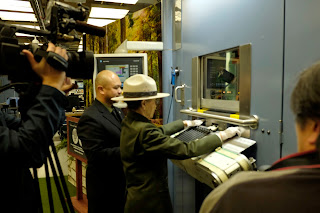I’m still griping about the lack of a decent speedlight for those all to frequent “run and gun” situations where you need the help of TTL automation when shooting quickly under a variety of conditions. Certainly, flashes like the Yongnuo 560 and more recently the Adorama Li-On powered units can be perfectly suitable when there’s enough time to make a “ranging shot” to adjust flash output. On other hand, an older Nikon speedlight with non-TTL exposure automation might do in a pinch, particularly in flash fill situations where exposure isn’t critical, as in putting a spot of light into the shadows on a sunlit day.
True TTL was a major advancement, allowing accurate exposures to be calculated from within the camera and through the shooting lens. iTTL is far more sensitive, providing accurate exposures even when the amount of light on your subject relatively low, as it would be when bouncing off of high ceilings or over longer distances. But under these circumstances, the Fuji EF-42 just doesn’t have the horsepower or the fast recycle time. I considered buying a used one and adapting it to a Quantum battery pack, something that would be easy to do, in theory. Maybe next year…
In the mean time, I’ve decided to try using some older Nikon SB-80 speedlights. First off, I already have several of them, and they have the same control layout as my beloved SB-800s. And while they aren’t adaptable to Nikon iTTL cameras, they do have the non-TTL exposure mode. When fast recycling time is needed, I have SD-8a battery packs. Not as fast as the Adorama units, which are bulkier and lack the non TTL automation.
 |
| Photo #1 |
 |
| Photo #2 |
The easiest way to attach the gel is to place each strip of tape sticky side up and lay the gel on top. When both side have their tape, you can trim the tape with a pair of sharp scissors. If you check Photo #1 again, you'll see that the arrangement is "light tight", and will produce the proper color throughout.
 |
| Photo #3 |
In The Field: When I carried my Nikon bag, I always had three speedlights. With the Fuji bag, there are still three speedlights: one Fuji EF-42, and two Nikon SB-80s, one with the gel already mounted.This allows me to instantly retrieve a gelled, or un-gelled flash on a moment's notice. If for some reason I need all of the speedlights un-gelled, I found it faster to remove the gel than to try to tape in on properly when I needed it. And as it turns out, installing the gel from the side of the flash is much faster than fishing through my camera bag, removing the gel from its protective sleeve, and positioning it under the flash panel.
Rosco Gel Sheets: The easiest way to obtain a supply of gels is to purchase the Rosco Strobist Assortment. However, since color correcting for incandescent light sources is pretty much my "go to" gel, I found it easier to purchase the by the sheet and cut them to size.
Everybody talks about the "CTO", or Full Orange gel, but when I checked the Rosco catalog, there are two suitable choices:
#3407, or Full CTO, which converts 5500 Kelvin to 2900 Kelvin, closer to the color of a household light bulb.
#3401, or RoscoSun 85, which converts 5500 Kelvin to 3200 Kelvin, closer to the color of a Type B photoflood.
Either works, but the 3407 is a bit warmer, although I doubt anybody could see the difference 300 degrees Kelvin would make unless they were compared side by side.
 |
| Fuji X100 S with WCL Wide Angle Conversion Lens: 1/64 of a second, ISO 800, F 4.0 |

























